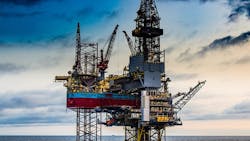Offshore staff
COPENHAGEN, Denmark – Maersk Drilling plans to upgrade its ultra-harsh environment jackup Maersk Intrepid to a hybrid rig with low nitrogen oxide (NOx) emissions for operations offshore Norway.
The company is performing the work in co-operation with client Equinor: the upgrades include adding data intelligence to further reduce energy consumption and carbon dioxide (CO2) emissions.
“It should be noted that the upgrades will not only produce a low-emission profile for the rig; they will also result in cost savings for our customer due to lower energy consumption,” stressed Maersk Drilling’s Morten Kelstrup.
The company has applied successfully for project funding through the NOx Fund, a Norwegian industry arrangement dedicated to reducing NOx emissions. The fund will contribute up to 80% of the project costs, subject to verification of the emission-reducing upgrades, and the backers see this upgrade program as a benchmark for the offshore industry.
“Hopefully we will see more of these and similar solutions on board rigs going forward,” said Tommy Johnsen, general manager of the NOx Fund.
The first stage will be to install batteries for the hybrid power solution, expected to be completed in July, with full implementation of all low-emission upgrades likely to be completed by the end of 2019.
Maersk Drilling will assess the experience to determine potential upgrades to reduce emissions from other rigs.
The Maersk Intrepid is an XLE jackup built in 2014 and is currently contracted to Equinor for operational support on the Martin Linge field development in the Norwegian North Sea.
The low-emission upgrades comprise:
- Hybrid power
Energy use on board a rig is characterized by high peak loads during certain operations. Through use of batteries for energy storage, power will be instantly available when needed: this means that fewer engines operating at a higher intensity can supply basic energy requirements, an arrangement said to be more efficient and with lower CO2 emissions. - Energy Emission Efficiency software
Maersk Drilling’s cloud-based Energy Emission Efficiency (EEE) software employs real-time data to monitor all energy use on board the rig, allowing for continuous optimization. For example, by switching off engines when they are not needed. Live tests of EEE have demonstrated a high energy saving potential, the company claims. - SCR units to reduce NOx emissions
Selective Catalytic Reduction (SCR) systems capture NOx exhausts and use ammonia injections to convert the gas into water and nitrogen. By installing SCR units on the rig’s engine exhaust pipes, the company expects to cut NOx emissions by more than 90%, while also reducing soot emissions.
05/09/2019



